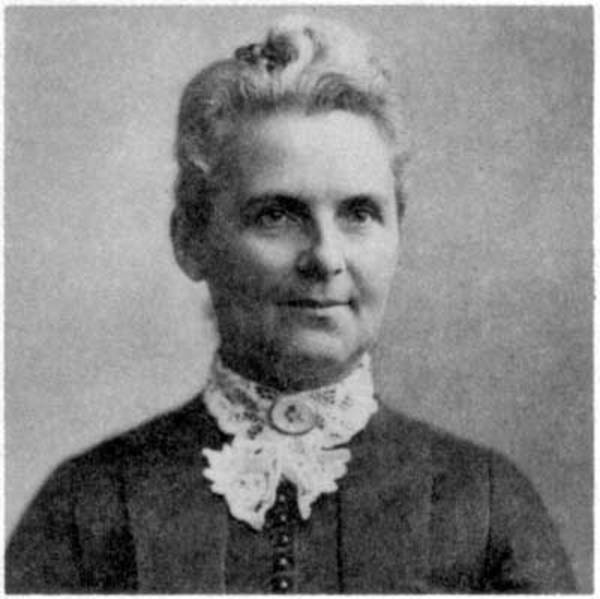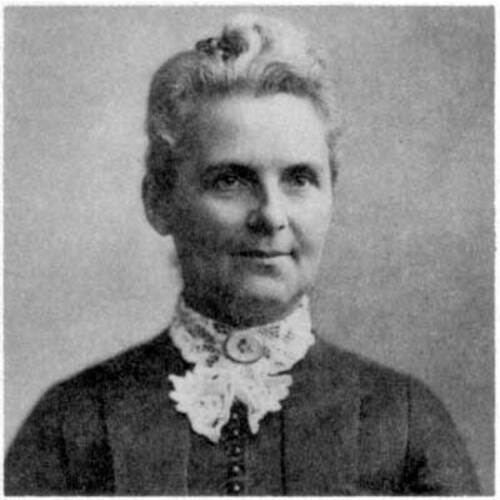
Source: Link
bingham, Elizabeth (Young), lay Methodist missionary and author; b. 10 April 1843 in Bradford, Upper Canada, eldest child of Joseph Bingham, a tanner and bootmaker, and Clarissa Vanderburgh, of New York loyalist descent; m. 25 Dec. 1867 Egerton Ryerson Young* in Toronto, and they had eight children, of whom three died in infancy; d. there 29 May 1934.
Elizabeth grew up in Bradford, where she attended public school. The family was active in the local Wesleyan Methodist church; Elizabeth sang in the choir and played the organ.
In late 1867 Elizabeth married Egerton Ryerson Young, with whom she had begun a childhood romance when his father served as minister of their church from 1853 to 1855. She joined her husband in Hamilton, where he had recently been ordained as a minister and assigned to that city’s First Methodist Church, but they would not stay there long.
Early in 1868 the Wesleyan Methodist Church in the new province of Ontario was organizing an expedition under George Millward McDougall* and George Young* to provide new staff for the missions that James Evans*, Robert Terrill Rundle*, and others had established in Rupert’s Land in 1840. Less than a month after the Youngs’ marriage the superintendent of missions, Enoch Wood*, asked them to join the group, which included the Reverend Peter Campbell and his family. The young couple accepted, and the party left in May.
Following two months and 19 days of travelling by ship and train to St Paul, Minn., by Red River cart northward, and then by York boat the length of Lake Winnipeg, the Youngs reached the Rossville mission near Norway House (Man.) on 29 July 1868. Elizabeth recorded many of her experiences in her personal writings; her 1927 memoir highlights details of the journey not found in her husband’s accounts. While buying supplies at St Paul the women purchased “Quaker poke bonnets,” and attached to them long veils weighted down with shot to ward off mosquitoes and flies. Sometimes she drove their horse and wagon while her husband hunted prairie chickens, a novel food for them both. On the ten-day trip along Lake Winnipeg, a large ox tethered in front of the Youngs’ seats made for objectionable company and they had to climb over it each time they camped onshore.
At the Rossville mission Elizabeth quickly became absorbed in the wants and needs of the local Crees. In her memoir she wrote: “We began at once making broths, soups, for the sick, & feeding the hungry. We quickly found out what we were there for.” The mission was a critical resource for the community, and the Youngs offered whatever medical help they could with their meagre supplies. Elizabeth treated injuries and prescribed sweating powders, castor oil, and painkillers, while trying to control dosages so that supplies were not consumed all at once. Food was often scarce and she described their diet, when there was enough to eat, as consisting of fish 21 times a week with some occasional game meat and “watery potatoes.” In 1869 she was unable to nurse her son Egerton Ryerson, called Eddie, the eldest child and the first of three born in the mission field, and believed that the reason was malnutrition.
The next year smallpox threatened the region. Many were so ill that, as Elizabeth wrote in her memoir, “the mission was more like a hospital than a mission home.” The Hudson’s Bay Company provided the Youngs with some lymph to vaccinate people, and the couple organized a brigade of Rossville Crees led by Samuel Paupanekis, brother of the Reverend Edward Paupanekis*, to bring supplies to afflicted areas along the Saskatchewan River.
Other duties included presiding over weekly women’s prayer meetings at which Elizabeth sometimes distributed warm clothing donated by English Methodists. She also dealt with awkward mistakes, as when contributors sent a large case of bonnets of varied styles and fashions that the Rossville women found incompatible with their shawls and blankets. Each New Year’s Day, at the church, she organized a “Christian feast,” which was attended by several hundred people.
In the summer of 1873 Elizabeth’s husband was asked to go on tour across Ontario with the Reverend Thomas Crosby* to raise funds for missions. While he awaited his successor and prepared for the move to Berens River (Man.), where he and Elizabeth would found a mission the next year, she set out for Ontario with their three children. They had to contend with Lake Winnipeg storms and heat during their journey south by York boat, and her ailing infant daughter, Nellie Elizabeth, died. The Cree boatmen made her a coffin, and Archdeacon Abraham Cowley* arranged for her burial at the Indian settlement at St Peter’s. The year that followed was strenuous as Elizabeth and her surviving children, having no home of their own in Ontario, visited her mother and spent time with other relatives.
Egerton began work among the Ojibwe at Berens River in the spring of 1874. The family joined him early that summer, sharing a 12 by 12 foot log cabin, with a roof made of poplar logs and clay, until a suitable house was built. During the winter measles hit the community severely, and the church, mission house, and a large bison-skin tent were used to shelter the sick. Elizabeth’s son, Eddie, later remembered how his mother helped over 400 people recover during the epidemic. On 20 Sept. 1875 the Youngs both signed Treaty No.5 as witnesses along with principals Lieutenant Governor Alexander Morris*, Chief Jacob Berens*, and others. At Berens River Elizabeth found that the work of establishing a new mission, along with growing family duties and health issues, meant that she formed fewer connections with the local people than those she had enjoyed at the Rossville mission, a community which had existed for 28 years by the time the Youngs arrived in 1868.
The Youngs left Berens River in the summer of 1876, citing Elizabeth’s health as their primary reason. They had another concern: Eddie, approaching school age, was assuming Cree ways under the fond care of his Norway House nurse Mary Robinson, known to the family as Little Mary, who had accompanied them to Berens River. Eddie found the transition to a rural Ontario school very painful. He and Elizabeth later vividly recalled his troubles in Port Perry, where Egerton was pastor from 1876 to 1879. Among other things, she “was very much annoyed with the boys teasing him and calling him Indian names.” At home, Eddie’s parents made efforts to maintain the use of the Cree language in hymns and prayers, and they and their son would write warmly and at length about their northern experiences.
Methodist ministers were reassigned to different churches every three years, and the family lived in Colborne, Bowmanville, Meaford, and Brampton between 1879 and 1888. Egerton senior ended his Brampton term early and turned to writing books and going on lecture tours to tell of his experiences and build support for missions. Elizabeth accompanied him on several trips; they travelled around the world in 1904–5, with an extended stay in Australia. According to Eddie, she “added not a little to the attractiveness of his lectures by singing a song or two in Cree.” Her skill in the language exceeded that of her husband: he had preached and travelled in the north with an interpreter, whereas she had dealt directly with individuals and their daily needs. Her attachment to the language endured; in her later years she was known to sing Wesleyan Methodist hymns to herself in Cree on Sunday mornings from a hymnal written in Cree syllabics. After her husband died in 1909, the family house in Bradford was sold. Elizabeth spent her remaining years living with her children and their families in Toronto and sometimes with a daughter in England.
Elizabeth published a two-part article in the February and March 1898 issues of the Indian’s Friend (Philadelphia) entitled “The transformed Indian woman,” which expressed a central theme in mission writing: the improvement in the quality of life of the women whose husbands had converted to Christianity and thus became, according to Elizabeth, more “gentle and sympathetic.” “To me as a woman,” she later wrote, “one of the most delightful phases of our work was to see the gradual uplifting and increased happiness of our Indian Sisters.” She was remembered at her death, at the age of 91, for her character and spirit, and as the last surviving member of the band of Methodist missionaries who had set out for the northwest in 1868.
Elizabeth Bingham Young is the author of “The transformed Indian woman,” Indian’s Friend (Philadelphia), 10 (September 1897–August 1898), no.6: 9–10; no.7: 9–10. Her extensive writings about her life and work at Norway House and Berens River appear, along with the memoirs of her son E. Ryerson Young [Jr], in Mission life in Cree-Ojibwe country: memories of a mother and son, ed. and intro. J. S. H. Brown (Edmonton, 2014).
UCC, F 3607 (Egerton Ryerson Young fonds). Canadian Statesman (Bowmanville, Ont.), 7 June 1934. Evening Telegram (Toronto), 30 May 1934. Toronto Daily Star, 30 May 1934. Bruce West, “Ancient Cree,” Globe and Mail, 15 June 1966. J. S. H. Brown, “A Cree nurse in a cradle of Methodism: Little Mary and the Egerton R. Young family at Norway House and Berens River,” in First days, fighting days: women in Manitoba history, ed. Mary Kinnear (Regina, 1987). Isaac Cowie, The company of adventurers: a narrative of seven years in the service of the Hudson’s Bay Company during 1867–1874 … (Toronto, 1913). J. W. R. McIntyre and C. S. Houston, “Smallpox and its control in Canada,” Canadian Medical Assoc., Journal (Toronto), 161 (July–December 1999): 1543–47. E. R. Young, By canoe and dog-train among the Cree and Salteaux Indians, intro. M. G. Pearse (Toronto, 1890). E. R. Young [Jr], “Elizabeth Bingham Young,” Missionary Monthly (Toronto), August 1934: 340–43.
Cite This Article
Jennifer S. H. Brown, “BINGHAM, ELIZABETH (Young),” in Dictionary of Canadian Biography, vol. 16, University of Toronto/Université Laval, 2003–, accessed April 25, 2025, https://www.biographi.ca/en/bio/bingham_elizabeth_16E.html.
The citation above shows the format for footnotes and endnotes according to the Chicago manual of style (16th edition). Information to be used in other citation formats:
| Permalink: | https://www.biographi.ca/en/bio/bingham_elizabeth_16E.html |
| Author of Article: | Jennifer S. H. Brown |
| Title of Article: | BINGHAM, ELIZABETH (Young) |
| Publication Name: | Dictionary of Canadian Biography, vol. 16 |
| Publisher: | University of Toronto/Université Laval |
| Year of revision: | 2021 |
| Access Date: | April 25, 2025 |




